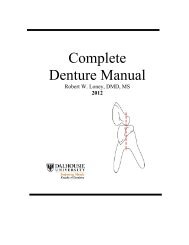RPD Manual 11 - Removable Prosthodontics - Dalhousie University
RPD Manual 11 - Removable Prosthodontics - Dalhousie University
RPD Manual 11 - Removable Prosthodontics - Dalhousie University
Create successful ePaper yourself
Turn your PDF publications into a flip-book with our unique Google optimized e-Paper software.
Direct and Indirect Retainers - 58<br />
3. Anterior teeth with indirect retainers are supported against lingual movement.<br />
4. Indirect retainers act as an auxiliary rests to support a portion of the major connector. For<br />
example, a lingual bar may be supported against settling into the tissues by an indirect<br />
retainer acting as an auxiliary rest.<br />
The indirect retainer may take any one of several forms. All are effective proportional to their<br />
support and the distance from the fulcrum line that they are placed.<br />
1. Auxiliary cingulum rests. The cuspid is the most easily utilized anterior tooth for<br />
preparation of a rest seat since the cingulum is usually more prominent than the lateral or<br />
central incisors.<br />
2. Auxiliary occlusal rest. Usually placed on the mesial occlusal of a first bicuspid tooth when<br />
their is inadequate cingulum tooth structure on the canines or there is poor access to the<br />
lingual surfaces of the anterior teeth.<br />
3. Continuous bar retainers and lingual plates. Technically, continuous bar retainers and<br />
lingual plates are not indirect retainers since they rest on unprepared lingual inclines of<br />
anterior teeth. The indirect retainers are actually the terminal rests at either end in the form<br />
of auxiliary occlusal rests or canine rests.















